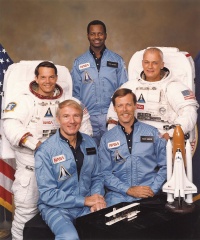STS-41B
From The Space Library
 | |
| Organization | NASA-Office of Space Flight (United States) |
|---|---|
| Mission type | Human Crew |
| Launch date | February 3, 1984 |
| Launch vehicle | Space Shuttle |
| Launch site | Cape Canaveral, United States |
| COSPAR ID | 1984-011A |
| Inclination | 28.45 degrees |
| Experiments | Here |
| Alternate Names | STS 10,14681 |
| Additional Information | Here |
| Data Collection | Here |
| Payload Mass Up | 15342 kg |
| Payload Mass Down | 8638.64 kg |
| Orbiter | Challenger |
| Lift Off Mass | 2,044,746.82 kg |
| Orbiter Weight at Liftoff | 113,765.91 kg |
| Orbiter Weight at Landing | 91,471.82 kg |
| Landed | Runway 15 at Kennedy Space Center, Fla. |
| Orbits of Earth | 127 |
| Orbital Altitude | 165 nautical miles (189 statute miles) |
Contents |
[edit] Crew
- Commander: Vance Brand
- Pilot: Robert Gibson
- Payload Commander:
- Mission Specialist 1: Bruce McCandless
- Mission Specialist 2: Robert Stewart
- Mission Specialist 3: Ronald McNair
- Mission Specialist 4:
- Mission Specialist 5:
- Payload Specialist 1:
- Payload Specialist 2:
ISS/Mir Crew Transport
[edit] Mission
STS 41-B was the fourth Challenger shuttle flight with Vance Brand, Robert Gibson, Bruce McCandless, Ronald McNair, and Robert Stewart on board. Misson Highlights consisted of the first untethered space walks by McCandless and Stewart, using manned maneuvering unit. WESTAR-VI and PALAPA-B2 satellites were deployed, but failure of Payload Assist Module-D (PAM-D) rocket motors left them in radical low-Earth orbits. German-built Shuttle Pallet Satellite (SPAS), first flown on STS-7, became the first satellite refurbished and flown again. SPAS remained in the payload bay due to electrical problem with Remote Manipulator System (RMS). The RMS manipulator foot restraint was first used, and practice procedures performed for Solar Maximum satellite retrieval and repair planned for next mission. Integrated Rendezvous Target (IRT) failed due to internal failure. Five Get Away Special canisters were flown in the cargo bay and a Cinema-360 camera was used by the crew. Other payloadsconsisted of : Acoustic Containerless Experiment System (ACES); Monodisperse Latex Reactor (MLR); and Radiation Monitoring Equipment (RME), and Isoelectric Focusing (IEF) payload. The mission duration was 191 hours 15 minutes 55 seconds.
[edit] EVA
Extravehicular Activity (EVA) conducted by Bruce McCandless and Robert Stewart during two spacewalks for a total of 11 hours, 37 minutes. EVA 1, 5 hours, 35 minutes; EVA 2, 6 hours, 2 minutes. First flight of the manned maneuvering unit (MMU). McCandless operating time 1 hour, 55 minutes; Stewart, 44 minutes.
[edit] Payload
PALAPA-B2 (Indonesian communications satellite) with Payload Assist Module (PAM)-D and WESTAR (Western Union communications satellite)-Vl with PAM-D deployment. Both satellites were deployed but the PAM-D in each satellite failed to ignite, leaving both satellites in Earth orbit. Both satellites were retrieved and returned to Earth for renovation on the STS-51-A mission. The manned maneuvering unit (MMU) was tested with extravehicular astronauts as free-flyers without tethers as far as 320 feet from the orbiter. Shuttle Pallet Satellite (SPAS)-01 experiments; Monodisperse Latex Reactor (MLR); Isoelectric Focusing Experiment (lEF); Acoustic Containerless Experiment System (ACES); Cinema 360 cameras; five getaway specials (GAS); Aerodynamic Coefficient Identification (ACIP)/High Resolution Accelerometer Package (HIRAP)
[edit] Books about the Space Shuttle Program
Buy This Book Click here |
Buy This Book here |
Buy This Book Click here |
Buy This Book Click here |





